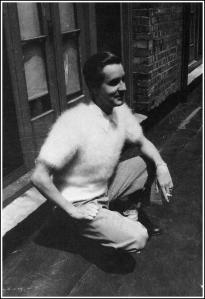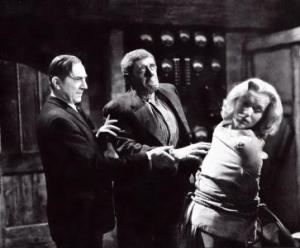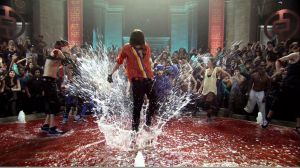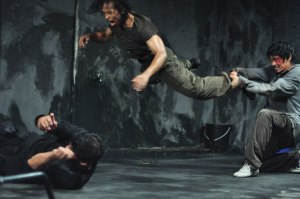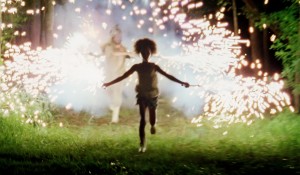Ratings: The Violent Years (1956), 2.5/5; Night of the Ghouls (1959), 3/5; The Sinister Urge (1960), 2.5/5; Ed Wood (1994), 5/5
“I look at this slush and I try to remember, at one time I made good pictures.” – Johnny Ryde, The Sinister Urge
Edward D Wood Jr is a fascinating character; those who have heard of him will probably already know all the famously quirky anecdotes surrounding him – he was a transvestite, he was the worst director of all time, Plan 9 From Outer Space is the worst film of all time. He is best known for three movies: his debut feature Glen or Glenda; mad scientist movie Bride of the Monster; and sci-fi/ horror hybrid Plan 9 (it’s also these three films that feature in Tim Burton’s big budget biopic). The films I watched for this Woodathon represent some of his lesser known features. Arguably none of them are as “bad” as his better known films, and probably none are as entertaining as a result. What is important to remember is that being known as the “worst director of all time” doesn’t mean that there can’t be moments that work – Night of the Ghouls in particular, while obviously low budget, actually suggests the writer-director-editor-actor-producer wasn’t entirely oblivious to his previous films’ failings. But more on that later.
First up, The Violent Years. Written by Wood, this juvenile delinquency movie is directed by William Morgan, better known as an editor (his work includes several episodes of Lassie, and Portrait of Jennie). While the language is clearly Woodian, the picture itself is a far more gloomy affair: particularly in later years, with long-time collaborator William Thompson working as Director of Photography, Wood’s films were visually sparse, but crisp, and this sharpnesss is missing from this movie. The plot itself is fairly unremarkable – a judge introduces the story (to add gravitas) of a young girl who, not receiving any attention from her parents, turns to a life of crime with her girlfriends. It’s a typical kind of movie for the time, with a typical kind of conclusion not dissimilar from the earlier exploitation pictures – it serves both as titillation (girl gangs, guns, fights, lots of smooching, and even the implied rape of a young man by the gang) and as a warning against considering such a lifestyle, cheekily justifying the presentation of such titillation in the first place. Jean Moorhead is good as Paula Perkins, the leader of the gang; the rest of the girls are non-distinct. Poor Mr and Mrs Perkins get all the blame – at barely an hour in length, oddly the “violent years” themselves are notably brief and Wood’s script gets significantly more preachy as it progresses, with the judge berating the parents and, oddly, claiming that a return to religion would fix this ghastly teenage problem. An interesting, short little curio, the film is largely unremarkable, though undoubtedly benefits from the Wood connection.
Next, Night of the Ghouls. This is Wood’s best known later film and, at the risk of sounding controversial, one of his most interesting movies. It’s his most light-hearted picture, and his most self-aware; it’s also his first feature film not to star Bela Lugosi. This is a shame, because Dr Acula (yes, you’ve read that correctly) is in many ways a role made for Lugosi, initially at least – Kenne Duncan, a legitimate actor with over 270 credited roles, does bring some authenticity to the performance, and seems to be having fun with the ridiculous, tongue-in-cheek premise.
After a strange introduction from legendary hack psychic Criswell, appearing as himself, which includes some vague social commentary about the youth of today (over footage of Ed Wood himself and Wood regular Conrad Brooks having a fight outside an icecream parlour before a car spins wildly out of control and careens down a cliff) Night of the Ghouls starts properly. Despite this introduction, the film is actually about a fake medium, Dr Acula (aka Carl), who preys on mourners for monetary gain. It’s also a kind-of sequel to Bride of the Monster – Acula’s home is built on the ground of the house on Willows Lake, and characters specifically refer to the events of that film. Lobo (Tor Johnson) also features here, having apparently survived the atomic blast that ended Bride of the Monster; so too does Kelton the Cop (Paul Marco), who confuses matters even more by lamenting his latest assignment: his remarks of “Monsters! Space people! Mad doctors!” implicitly also refers to this characters’ appearance in Plan 9 as well.
And there’s more: there’s a crude “Wanted” poster on the wall of the police station, with a headshot of Wood himself below. The lieutenant (Duke Moore, another acting veteran) does his entire investigation wearing a top hat and tails, most probably so that Wood could include a whole section of the short film Final Curtain in this production (legend has it that Lugosi was reading the script for Final Curtain when he died). But most interesting are Acula’s methods of conning his victims. His seances, which take place in barely constructed sets (lots of curtains, bits of carpet lining parts of the floor), include some particularly shoddy effects – a trumpet floats, with the strings holding it up clearly visible in the shadow; a person wearing a sheet (yes, really) crab-walks across the frame; a cup and saucer bob around in front of yet another curtain. These effects are terrible, yet no worse than the UFOs in Plan 9, but – and here’s the point, they are revealed to be fake. On first viewing, knowing the infamy of Wood’s previous films, it’s easy to revel in the ridiculousness of his effects, but the joke is on us in the end. Perhaps I’m reading too much into it (it’s easy to do with Wood’s movies), but surely the fact that he actually includes a flying (cup and) saucer is a deliberate nod to his previous film’s inadequacies?
Night of the Ghouls, for whatever reason, has never received as much notoriety as Wood’s earlier movies – it’s best known for being the movie that remained unreleased for twenty-three years due to the director being unable to pay the lab processing fees. Perhaps part of the reason it is not as cherished as Plan 9 or Glen or Glenda is that, quite simply, it lacks the naivety of these badfilm classics. It seems as though Wood is having fun here, but also that he is at least somewhat aware of his limitations and, importantly, he’s intentionally playing with the audience’s expectations. In the realm of badfilm, even the weakest attempts at self-awareness are not particularly embraced – it’s the innocence and unintentional badness that captivates people, and with Wood in particular no one wants to believe that he was ever anything other than enthusiastic, but hopeless.
Next, The Sinister Urge. This film serves as a warning against pornography and “smut” pictures, taking on a similar format to The Violent Years. Ironically, it is the last feature film Wood made before his descent into pornography (see One Million AC/DC as one of the last surviving Wood pictures). Much like The Violent Years, it is neither a particularly good movie, nor is it bad enough to be considered one of Wood’s “masterpieces” – as much as people may not want to admit it, his later films did contain significantly more acceptable filmmaking standards, suggesting that the man was learning and developing his technique. The Sinister Urge is fairly unmemorable, save a few moments: one includes an entirely unrelated fight that takes place in an icecream shop – yes, that’s Wood and Brooks grappling around in the sand, with the scene taken from Night of the Ghouls. In typical Wood fashion, there are some winks to the Wood-universe: posters for his previous films line the walls of one of the smut directors, who says they are “made by friends of mine.” There’s also a large subplot about a girl arriving in Hollywood from a small town that is repeated in (or taken from) Hollywood Rat Race, a truly fascinating book written by Wood on how to “succeed in Hollywood.” Other than that, the film is generally unremarkable – there’s a brief moment of actual nudity, which is unusual, and there’s a fun game to be had in seeing just how many outfits Jean Fontaine’s porn-kingpin wears over the seventy minutes, but it’s a fairly dry movie, with too much time spent in the police station and, for a film all about the porn business, not half enough nudity.
Interestingly, none of these films are mentioned in Ed Wood, Tim Burton’s fanboy biopic. It’s a wonderful film nonetheless, inspired by Rudolf Grey’s excellent biography, Nightmare of Ecstasy, with Johnny Depp bringing a wonderful, boyish energy to the enigmatic director. Yet it’s as much a film about Lugosi as it is about Wood – Martin Landau is superb as the former star, and he deservedly won an Oscar for his performance (ironically Lugosi never received such acclaim). The film emphasises the friendship between the director and star – and, by all accounts, they truly were friends, with a mutual respect and admiration at the core of their relationship. It is, of course, a highly stylised biopic, with plenty of liberties taken; whole sections are fabricated, including an important pep-talk Wood receives from his (real) hero Orson Welles – so too is the way in which Plan 9 is finally shown to the world. Yet all the strangest, weirdest bits are true: the stolen octopus and its missing motor; the entire cast and crew getting baptised in a swimming pool so that Plan 9 would get its funding; the reasons for Bride of the Monster ending with a nuclear bomb… And there are parts that may or may not be true – not even Grey manages to establish the “truth” in his biography, with personal anecdotes contradicting each other and Wood himself reiterating myths and legends.
Burton’s biopic, as loving and inoffensive as possible, glosses over the darker side of Wood – the film ends with Plan 9‘s first screening, and only alludes to the filmmaker’s troubles after that – and is arguably as instrumental as the Medveds in establishing the cult of Ed Wood. Shot in black and white, it’s ironically a big budget, expertly shot, well crafted movie, one that pays homage to Wood but never makes fun of him, presenting him as always optimistic, charismatic and handsome, filled with enthusiasm, surrounded by a random assortment of Hollywood rejects (portrayed with aplomb by the likes of Bill Murray, Jeffrey Jones and, in a particular coup, bona fide wrestling legend George “the Animal” Steele as Tor Johnson) yet always upbeat and prepared for success that somehow never quite materialises.
I always wonder how Wood would have felt about his films being considered some of the “worst of all time.” He died two years before the Medveds’ readers voted him worst director, a bloated, homeless alcoholic. While today his fans like to think he would be pleased at his films’ current popularity, surely it would sting just a little to know the reasons for their fame? As he said, in Hollywood Rat Race: “It’s terrible to hear someone say about someone else’s work, ‘Ahh, that stinks.’ Yet the critic probably couldn’t ink his way out of a paper bag. You put it on paper. Good, bad, or indifferent. At least you had the guts to put it there.”
